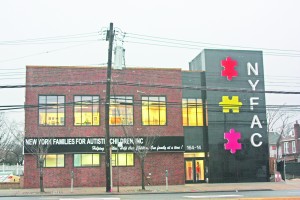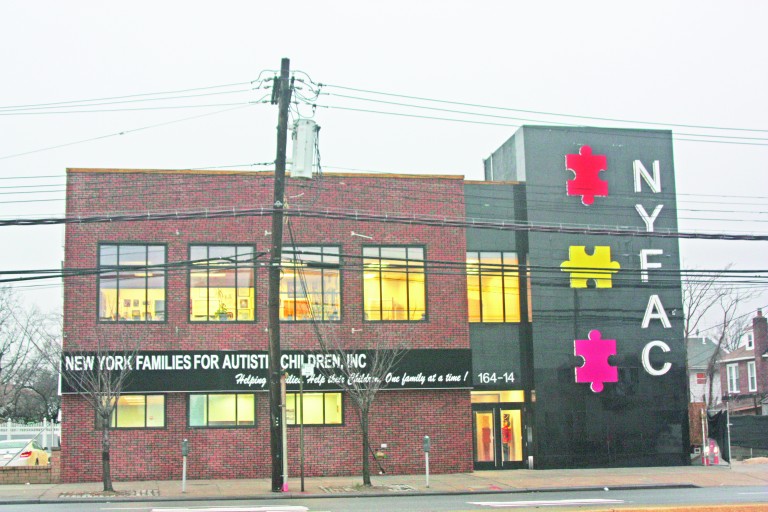
Although the facade of NYFAC's new home on Cross Bay Boulevard now as though nothing ever happened, the interior of the building was virtually destroyed losing tens of thousands of dollars just in electrical circuitry.
For New York Families for Autistic Children, (NYFAC), the road to their dream destination––a comprehensive autism community center in Howard Beach–– has been a long one. According to founder & CEO Andrew Baumann, the idea was born nine years ago, in 2004, at a cocktail party at Russo’s on the Bay.
The idea to build the center went from discussion stages to being NYFAC’s first capital campaign very quickly. And with almost as much speed, came the success of that campaign. Private donations from residents in many communities poured in. Local politicians got on board––fundraising was well under way. And with money, also came donations of musical instruments, games, books and equipment essential for children, teens and adults with autism.
To make a very long, hard story short, NYFAC raised almost $5 million within the first few years and the dream moved even closer to reality. Setting aside $3 million to secure a property, the remaining $2 million was slated for renovations and outfitting. Money came from the New York City Council, from the mayor’s Fund from the Assembly, the senate and from Congress.
Former Assembly member Audrey Pheffer got $200,00 of funding to get fitted for solar power in keeping with the go green platform of the building. Another grant from Rep. Gregory Meeks brought $300,000 into the mix to maintain the highest levels of energy efficiency.
The building was to be used not only as a place to provide services and support, but to act as a training facility for professionals to learn about the world of autism. To that end, a state of the art TV studio and technological training center were put in place. Councilman Eric Ulrich contributed $100,00 and Richmond County Savings Bank another $75,000. Things were going well after so many years of so much help and so much persistence. Things were going very well.
“We were so welcomed here.” Andrew Baumann is standing on Cross Bay Boulevard––his back to the traffic, staring at the face of the shining black building and the brightly colored puzzle pieces that represent autism. “Can you imagine,” Baumann begins, ‘Three months ago when I stood in front of this building, in this very same spot, I wept for joy,” pausing, he makes no attempt to wipe the tears that come freely now as he speaks, “standing in the same place now, I’m still weeping. But it isn’t for joy.”
The joy that Baumann remembers can be traced back most recently to the week of October 22, 2012. Finally NYFAC was ready. Millions of dollars later (and about 20% over budget), 18 months of construction completed The date was set for a November 12th ribbon cutting ceremony.
That same joy was accompanied by a great deal of thanks and appreciation; pride in work done, and in those who did it. It was finally ready, that building was. Willed by determination, filled with all the proverbial blood, sweat, tears and a lot of money. Built by the determination to do battle with autism.
But with devastating swiftness, Hurricane Sandy turned back the clock on NYFAC just far enough to shatter progress, halting plans for the ribbon cutting ceremony and bringing with it an entirely unexpected battleground .
Once past the initial shock, Baumann set about opening up the channels of help he was sure were going to be there. NYFAC is an organization heavily depended on by a special needs population. We are a not-for-profit. This is the United States of America. Andrew Baumann just knew he would be getting help. So he started to make the phone calls.
“First it was FEMA,” says Baumann. Upon calling he got the ‘no help for you––you’re a business routine.’ That’s when he says he followed directions to apply for assistance from the Small Business Administration(SBA) and with a big smile Baumann says softly, “I’m still waiting to hear from them.”
In addition to realizing all too quickly that the amount of work and undertaking in front of he and his staff was going to be monumental, the picture was also becoming very clear, that they would be doing a lot of it with no assistance at all and at a huge cost.
After what Baumann refers to as a very deep breath, one he jokes seemed two weeks long, assessment of the damage began.
“Walking through the building for the first time after the storm, all I saw was total destruction,” he says. And the description of what follows certainly supports his choice of words.
Floors literally buckled and pulled up from the ground; the elevator under water. Every mechanical system put in place was wiped out––in the building, on the roof, in the parking lot. The electrical panels submerged in a room where the water line approached four feet. The music room, filled with instruments donated by local families. The carpet, insulation , the studio equipment was all gone. The center also lost its fully equipped kitchen, including all cabinets and appliances along with tables, bookcases, chairs, computers, and tv’s
To add to NYFAC’s nightmare was the condition of their Ozone Park location. It had no heat, no power. Most of the staff’s case managers live in heavily affected areas of the storm. .
But Baumann knew the families NYFAC serves had been hit very hard and they would be counting on services. “What does a family do when 3-4 feet of water throws them into the street and they have a child or children with special needs?” he asked knowing the answer. They go to NYFAC. And Baumann says his staff was there for the families. “I’m very proud of our staff because they rallied together working in unison to get help for those hit hardest.”
Entering the rebuilding stage, with estimates are coming in and facing exorbitant costs in damages was overwhelming. Cost projections included an elevator, the electrical systems, the floors, the sheetrock, the furniture, the equipment, the toys and games and musical instruments. The answers were all there as to what needed to be done. Only one thing was missing. Where was the money coming from… Where are we gonna get this money from?
“Thank God we didn’t get the same response time when we reached out for our friends like we did when we went to the government.” A note of bitterness is evident in Baumann’s voice, it carries the tone of the one that’s become a universal dialect spoken fluently in any community where Sandy dropped by. Angry frustration with a touch of shock, outrage and disbelief all tossed in.
Within three days of submitting cost estimation figures, Baumann got a call. “It was our bank. New York Community Bank. They pre-approved a line of credit for us in the amount of 500 thousand dollars,” he says. “You gotta know I didn’t even have a chance to ask them…They were just there.”
The loan of course must be paid back but Baumann says that doesn’t matter. What matters is getting it done and setting a new date for the ribbon cutting.
Baumann says that everyone in NYFAC is back to work and they are anticipating a full recovery. They’ve launched a fundraising initiative and invite everyone interested in helping to view their video at www.nyfac.org.
By Patricia Adams

